In 2019 I read 43 books. And while this might seem outrageous, my original goal was an audacious 50 books. Either way, I consider it a great personal achievement, bolstering past the 27 books I read in 2018, the 19 in 2017, and a mere handful at best in 2016. Below is the full list along with my reflections of every one of these books, organized into arbitrary categories.
Some fun stats:
- Of the five works of fiction I read (that’s a lot for me), four were favorites for the year
- Five books were written by people I know personally
- A dozen were audiobooks – so about one a month
- Eleven books were authored by women
Jump to:
Favorites
(click title for full reflection)
Antifragile: Things That Gain from Disorder, by Nassim Nicholas Taleb (audiobook version)
If You See Me, Don’t Say Hi, by Neel Patel
The Sports Gene: Inside the Science of Extraordinary Athletic Performance, by David Epstein
The Windup Girl, by Paolo Bacigalupi
Gang Leader for a Day: A Rogue Sociologist Takes to the Streets, by Sudhir Venkatesh
Einstein’s Dreams, by Alan Lightman
Athletics
Complete Handbook of Speed Skating, by Dianne Holum
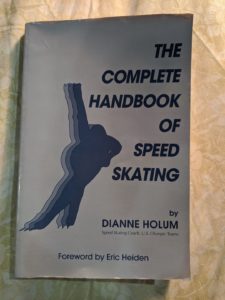 Upon seeing a picture of this book and noticing the author’s name, I had to pick it up, for it was written by the mentor of Eddy Skater, who’s my mentor. The book is a guide to training for Olympic level ice speed skating and unsurprisingly the author is not only the coach of Eric Heiden who’d won an unprecedented five individual gold medals at the 1980 Olympics, but an Olympic medalist herself. This book, despite being published in 1984 when inline skates were damn near impossible to come by, is extremely useful for inline skaters looking to become stronger and faster as it contains a great deal of exercises that are done off skates, as ice time was also hard to come by then. In that light, there’s plenty in this guide on putting together a yearlong training program – with details down to every day – that can apply to any athletic endeavor. At the same time, there’s plenty of skating specific exercises to bolster technique, strength, power, and speed; and some of them are quite challenging. The discussions on training for sprinting and training for endurance are pretty revealing and overall I look forward to incorporating many of the elements from this book, as well as similar ones gleaned from training with Eddy, into my 2020 regimen.
Upon seeing a picture of this book and noticing the author’s name, I had to pick it up, for it was written by the mentor of Eddy Skater, who’s my mentor. The book is a guide to training for Olympic level ice speed skating and unsurprisingly the author is not only the coach of Eric Heiden who’d won an unprecedented five individual gold medals at the 1980 Olympics, but an Olympic medalist herself. This book, despite being published in 1984 when inline skates were damn near impossible to come by, is extremely useful for inline skaters looking to become stronger and faster as it contains a great deal of exercises that are done off skates, as ice time was also hard to come by then. In that light, there’s plenty in this guide on putting together a yearlong training program – with details down to every day – that can apply to any athletic endeavor. At the same time, there’s plenty of skating specific exercises to bolster technique, strength, power, and speed; and some of them are quite challenging. The discussions on training for sprinting and training for endurance are pretty revealing and overall I look forward to incorporating many of the elements from this book, as well as similar ones gleaned from training with Eddy, into my 2020 regimen.
The Art of Falling: Freestyle Slalom Skating, by Naomi Grigg
 This book, written by my friend, mentor, and favorite slalom skater, is simply put an amazing resource to understand and excel at not only slalom skating, but every form of skating. Having first read through it four and a half years ago when I properly embarked on my journey of slalom skating, I’m again left feeling invigorated upon rereading it cover to cover as I once more find there’s so much ahead of me to learn, apply, and work on. It’s a good feeling.
This book, written by my friend, mentor, and favorite slalom skater, is simply put an amazing resource to understand and excel at not only slalom skating, but every form of skating. Having first read through it four and a half years ago when I properly embarked on my journey of slalom skating, I’m again left feeling invigorated upon rereading it cover to cover as I once more find there’s so much ahead of me to learn, apply, and work on. It’s a good feeling.
In the first portion of the book the author provides baseline information on principles of skating, equipment, and setting yourself up for progress. It’s rather entertaining (perhaps because of the author’s personality) as the author directly addresses things we often get hung upon like what kind of equipment we should use (it matters less than we think), safety (use your brain before blindly using your helmet), and trying to find the best training settings (most top skaters deal with what they got and just skate).
The second portion of the book is a guide to foundational moves with details on how to approach each of them through steps, images, diagrams, and tips. To me this part of the book seemed as confusing as it did helpful as, even with my existing knowledge, I found the steps difficult to understand and there were sometimes discrepancies between the sidedness of the step and what was shown in the diagram or pictures. It’s worth noting though that the author also states that a book isn’t really a good place to *learn* basic moves so perhaps we’re in agreement when I say it’s best to take the great list of moves and find videos to help. That said, the tips and troubleshooting portions of each move are solid and they definitely helped me personally when I was learning.
The third part of the book is pure gold as it dives into rarely considered yet essential principles of skating – especially pivots, style, flow, skills, drills, practice strategies, and competition tips. The big takeaway for me at this point is that I’m amped to rebuild my slalom foundation by consciously reworking every move in the form of pivots as it’ll set me up to learn the higher level moves that I’ve been having trouble with as of late. But regardless of your level, this book will provide you the tools to take your skating up a notch. I highly recommend the physical copy as there’s many pictures and diagrams but if you can’t find it, a digital version can do as the real meat of is in the words.
Endure: Mind, Body, and the Curiously Elastic Limits of Human Performance, by Alex Hutchinson (audiobook version)
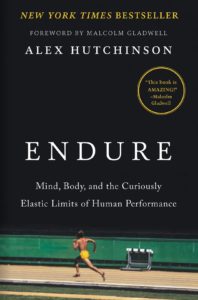 While we often think of physiology when it comes to athletic performance, this book delves deeply into the mental aspects that are involved. It explores many avenues (including physiological ones) and while they’re disparate and give the book a bit of a hodgepodge feel, each area is interesting in its own right. One avenue looks into how having a lack of memory on how much you’ve done (due to a brain problem in this case) can increase your endurance manyfold. Others explore the impact of diets and technological “innovations”. And then there’s cases of just having someone to compete against, whether it’s breaking their record or pushing past them in the heat of an event. This book focuses a lot on running performance as that’s where most data is, but the implications can apply to any endurance activity. If you’ve ever wondered why your race day performance always seems better than your practice times, you’ll have your answer here.
While we often think of physiology when it comes to athletic performance, this book delves deeply into the mental aspects that are involved. It explores many avenues (including physiological ones) and while they’re disparate and give the book a bit of a hodgepodge feel, each area is interesting in its own right. One avenue looks into how having a lack of memory on how much you’ve done (due to a brain problem in this case) can increase your endurance manyfold. Others explore the impact of diets and technological “innovations”. And then there’s cases of just having someone to compete against, whether it’s breaking their record or pushing past them in the heat of an event. This book focuses a lot on running performance as that’s where most data is, but the implications can apply to any endurance activity. If you’ve ever wondered why your race day performance always seems better than your practice times, you’ll have your answer here.How Bad Do You Want It?: Mastering the Psychology of Mind over Muscle, by Matt Fitzgerald (audiobook edition)
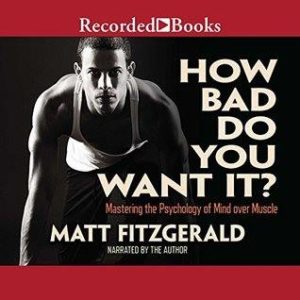 A friend recommended reading this book prior to competing in the Le Mans 24 Hour skate race which both of us were training and preparing for (the event was unfortunately ultimately shut down by the French government). It proved immensely relevant and helpful in addressing the most important thing missing from my training: the mental aspect. The author dives into a handful of psychological strategies that can help one attain maximum athletic performance and pairs the concepts with inspiring tales of athletes that used the strategy (often unknowingly) to reach new levels. Despite not getting the chance to apply the concepts at my event, it definitely addressed a lot of my pre-race qualms of how I’d handle rolling for longer than I’d ever done so. This book is great, and the only caveat I have is that the author focuses mostly on triathletes and cyclists. It would have been great to see examples from a greater range of physical endeavors.
A friend recommended reading this book prior to competing in the Le Mans 24 Hour skate race which both of us were training and preparing for (the event was unfortunately ultimately shut down by the French government). It proved immensely relevant and helpful in addressing the most important thing missing from my training: the mental aspect. The author dives into a handful of psychological strategies that can help one attain maximum athletic performance and pairs the concepts with inspiring tales of athletes that used the strategy (often unknowingly) to reach new levels. Despite not getting the chance to apply the concepts at my event, it definitely addressed a lot of my pre-race qualms of how I’d handle rolling for longer than I’d ever done so. This book is great, and the only caveat I have is that the author focuses mostly on triathletes and cyclists. It would have been great to see examples from a greater range of physical endeavors.
Changing Expectations In Special Olympics: A Guide to Basic Skill Acquisition, Health and Sport For Individuals with an Intellectual Disability, by Jacques Thibault
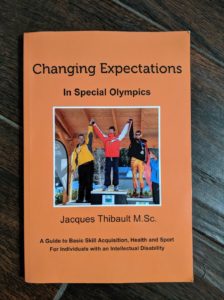 The author, who gave the keynote at Camp SkateIA’s instructor day, has had an illustrious life as a former olympic speed skater, a leader that’s helped bring slews of medals to entire olympic teams through his strategy of “changing expectations”, and most recently raised athletes with intellectual disabilities (ID) to a level that would rival professional athletes. This book centers on the last bit and it’s a revealing one. The author discusses how it is essentially total bullshit that we typically have such small expectations of ID athletes, from their barely competent performance at competitions to the absolutely minimal training time they get. He advocates instead that these athletes not only need to get the same amount of training time as their non-ID counterparts, but require additional focus to fully and substantially develop subskills that serve as building blocks for advancement and success at their sport – which interestingly enough is a big focus of the teaching model for SkateIA instructors. There’s lots more detail to this, including online resources for sport specific strategies and breakdowns that could serve coaches well. It was great reading this piece as it was super eye-opening.
The author, who gave the keynote at Camp SkateIA’s instructor day, has had an illustrious life as a former olympic speed skater, a leader that’s helped bring slews of medals to entire olympic teams through his strategy of “changing expectations”, and most recently raised athletes with intellectual disabilities (ID) to a level that would rival professional athletes. This book centers on the last bit and it’s a revealing one. The author discusses how it is essentially total bullshit that we typically have such small expectations of ID athletes, from their barely competent performance at competitions to the absolutely minimal training time they get. He advocates instead that these athletes not only need to get the same amount of training time as their non-ID counterparts, but require additional focus to fully and substantially develop subskills that serve as building blocks for advancement and success at their sport – which interestingly enough is a big focus of the teaching model for SkateIA instructors. There’s lots more detail to this, including online resources for sport specific strategies and breakdowns that could serve coaches well. It was great reading this piece as it was super eye-opening.
DangerMan’s Paintball Bible: Your Secret Weapon To Dominating Woodsball. It’s The Definitive Woodsball Paintball Manual, by Lars W Hindsley
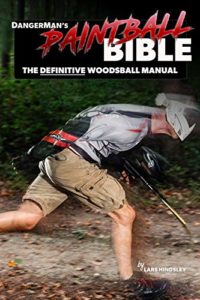 Written by a friend in the skating community who’s also an avid paintball player, this is a solid guide to understanding the game of paintball and developing proficiency at it. The author focuses primarily on woodsball (including rec ball) while also bringing in a decent bit of hyperball knowledge where relevant and for comparison. The general takeaway is that strategy matters over everything, especially athleticism, and the author delves into tons of application of tactics. Despite not being a paintball player myself, I found the book easy to follow thanks to a friendly and conversational approach along with plenty of diagrams and images. The author does a good job making the material approachable and relevant for beginners as well as more experienced players while avoiding the trap of coming off elitist, which is much appreciated. If you have any interest in paintball, or are curious to understand that there’s so much depth to this game than meets the eye, check out this book. I sure wish it’d been around for the one time I played many years ago as I’m certain my not so good experience would have turned out to be a great one.
Written by a friend in the skating community who’s also an avid paintball player, this is a solid guide to understanding the game of paintball and developing proficiency at it. The author focuses primarily on woodsball (including rec ball) while also bringing in a decent bit of hyperball knowledge where relevant and for comparison. The general takeaway is that strategy matters over everything, especially athleticism, and the author delves into tons of application of tactics. Despite not being a paintball player myself, I found the book easy to follow thanks to a friendly and conversational approach along with plenty of diagrams and images. The author does a good job making the material approachable and relevant for beginners as well as more experienced players while avoiding the trap of coming off elitist, which is much appreciated. If you have any interest in paintball, or are curious to understand that there’s so much depth to this game than meets the eye, check out this book. I sure wish it’d been around for the one time I played many years ago as I’m certain my not so good experience would have turned out to be a great one.
The Sports Gene: Inside the Science of Extraordinary Athletic Performance, by David Epstein
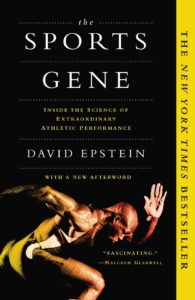 This was a fascinating book where a central theme is that the so called 10,000 hour rule is more a myth because its original interpretation is misguided and also because our genes indeed determine our potential range of abilities. Some of the many insights include that some people (including couch potatoes) are simply able to pick up physical arts faster due to genetic factors (and slow picker uppers never become fast), that early specialization in a sport is less likely to lead to success than having diversity across disciplines instead, and that different body types (genetically determined) allow for someone to be better suited for one sport over another if they wish to be at the upper echelon. That said, to be great at a particular sport or physical art, you might be doomed by your genetics, but more likely not, as hard work, training, and practice can get you to a high level of proficiency. Or a lucky stroke of genetics might make the path an easier one. While this book leaves me with many questions regarding my own pursuits in the physical arts, it’s also solidified much of the path I’ve taken thus far.
This was a fascinating book where a central theme is that the so called 10,000 hour rule is more a myth because its original interpretation is misguided and also because our genes indeed determine our potential range of abilities. Some of the many insights include that some people (including couch potatoes) are simply able to pick up physical arts faster due to genetic factors (and slow picker uppers never become fast), that early specialization in a sport is less likely to lead to success than having diversity across disciplines instead, and that different body types (genetically determined) allow for someone to be better suited for one sport over another if they wish to be at the upper echelon. That said, to be great at a particular sport or physical art, you might be doomed by your genetics, but more likely not, as hard work, training, and practice can get you to a high level of proficiency. Or a lucky stroke of genetics might make the path an easier one. While this book leaves me with many questions regarding my own pursuits in the physical arts, it’s also solidified much of the path I’ve taken thus far.
Race, Politics, History
American Nations: A History of the Eleven Rival Regional Cultures of North America, by Colin Woodard (audiobook version)
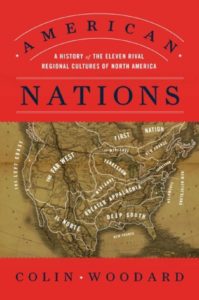 Between all the political bickering going on with friends across our country and the vast differences in lifestyles I’ve seen firsthand throughout my travels, I can’t help but think that America is more a conglomerate of different nations patched together than a single unified entity. According to the author, this is rather accurate. He points out that our notion of the country expanding from East to West is misguided and that instead different areas of America – eleven according to the author – developed independently from one another and eventually butted heads. The piece is surprisingly engaging as it starts with chapters on how each “nation” was founded moving on then to the conflicts and compromises that arose over time bringing us to the present day state of affairs. I found it fascinating that the greater NYC area, which the author calls New Netherland, prioritized anything that made for good business, recreating the highly diverse and tolerant culture ever present in Amsterdam at the time. That much of the Deep South was founded on principles of highly authoritarian social structures, which is present in the way religion plays a role in the areas to this very day. And that much of the northeast and beyond, dubbed Yankeedom, as well as the Left Coast (founded by Yankees), are based on Puritan self governing principles that are pushed onto everyone around them (white liberal elites much?). There’s also a rather common theme throughout the American history of white elite men blatantly screwing over everyone else including Native Americans, blacks, women, immigrants, other people of color, and non-elite whites. Although written 8 years ago, this piece is more timely than ever as it’s given me a much better understanding of how our country came to be, and I highly recommend it.
Between all the political bickering going on with friends across our country and the vast differences in lifestyles I’ve seen firsthand throughout my travels, I can’t help but think that America is more a conglomerate of different nations patched together than a single unified entity. According to the author, this is rather accurate. He points out that our notion of the country expanding from East to West is misguided and that instead different areas of America – eleven according to the author – developed independently from one another and eventually butted heads. The piece is surprisingly engaging as it starts with chapters on how each “nation” was founded moving on then to the conflicts and compromises that arose over time bringing us to the present day state of affairs. I found it fascinating that the greater NYC area, which the author calls New Netherland, prioritized anything that made for good business, recreating the highly diverse and tolerant culture ever present in Amsterdam at the time. That much of the Deep South was founded on principles of highly authoritarian social structures, which is present in the way religion plays a role in the areas to this very day. And that much of the northeast and beyond, dubbed Yankeedom, as well as the Left Coast (founded by Yankees), are based on Puritan self governing principles that are pushed onto everyone around them (white liberal elites much?). There’s also a rather common theme throughout the American history of white elite men blatantly screwing over everyone else including Native Americans, blacks, women, immigrants, other people of color, and non-elite whites. Although written 8 years ago, this piece is more timely than ever as it’s given me a much better understanding of how our country came to be, and I highly recommend it.
Fantasyland: How America Went Haywire: A 500-Year History, by Kurt Andersen (audiobook version)
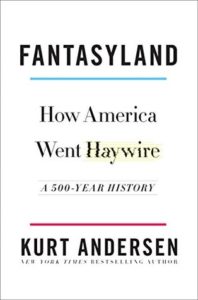 This piece had originally caught my attention a couple of years ago but I’d decided against reading it at the time because it seemed like it was just another piece hastily released to exploit our curiosity to understand how we got into the current societal and political circumstances of today. However, upon meeting the author at an artists’ retreat in Italy, I learned that the piece had been in the works long prior to the presidential election cycle, so I decided to check it out. This piece is very long and detailed, perhaps more repetitive than what I’d prefer, but I really appreciate the sheer amount of data the author presents to make his case. His case is that we Americans are prone to integrating fantasy into the core of our lives and we have been throughout the history of our nation. The author delves into story after story including our obsession with religious institutions (and literal interpretations of the Bible), theme parks (and how our cities and towns have become more like them), immersion events like war reenactments and Burning Man, our obsession with guns (along with the fantasy of the good guy with the gun), conspiracy theories, and the concept of “fake news”. He shows that the wacky world we Americans have found ourselves today isn’t something new, but a consistent theme that’s only gotten become more apparent and strengthened by our current media systems (very similar to the arguments made in “Amusing Ourselves to Death” which I’d read previously). While I found the piece to be extremely enlightening, I felt the author could have done more to show that much of the power of fantasy was exacerbated by individuals that exploited others for their own personal gain. Conversely, I would have liked to see additional explanation or theory to explain how social psychology played a role in our vulnerability towards fantasy. That said, this piece has really helped bring to focus certain notions I’ve noticed about our country: Like why non-Americans find American culture so fascinating. And that the very American mindset of freedom, liberty, and achieving any dream is a double edged sword with a dark side that we’re all guilty of. The audiobook version is read by the author so if you’re more a podcast person, I do recommend checking out that version.
This piece had originally caught my attention a couple of years ago but I’d decided against reading it at the time because it seemed like it was just another piece hastily released to exploit our curiosity to understand how we got into the current societal and political circumstances of today. However, upon meeting the author at an artists’ retreat in Italy, I learned that the piece had been in the works long prior to the presidential election cycle, so I decided to check it out. This piece is very long and detailed, perhaps more repetitive than what I’d prefer, but I really appreciate the sheer amount of data the author presents to make his case. His case is that we Americans are prone to integrating fantasy into the core of our lives and we have been throughout the history of our nation. The author delves into story after story including our obsession with religious institutions (and literal interpretations of the Bible), theme parks (and how our cities and towns have become more like them), immersion events like war reenactments and Burning Man, our obsession with guns (along with the fantasy of the good guy with the gun), conspiracy theories, and the concept of “fake news”. He shows that the wacky world we Americans have found ourselves today isn’t something new, but a consistent theme that’s only gotten become more apparent and strengthened by our current media systems (very similar to the arguments made in “Amusing Ourselves to Death” which I’d read previously). While I found the piece to be extremely enlightening, I felt the author could have done more to show that much of the power of fantasy was exacerbated by individuals that exploited others for their own personal gain. Conversely, I would have liked to see additional explanation or theory to explain how social psychology played a role in our vulnerability towards fantasy. That said, this piece has really helped bring to focus certain notions I’ve noticed about our country: Like why non-Americans find American culture so fascinating. And that the very American mindset of freedom, liberty, and achieving any dream is a double edged sword with a dark side that we’re all guilty of. The audiobook version is read by the author so if you’re more a podcast person, I do recommend checking out that version.
Black Klansman: Race, Hate, and the Undercover Investigation of a Lifetime, by Ron Stallworth
 This book was recommended to me upon discussing the movie that it’s based on, and I sure hope the movie is better than book. This is a quick and engaging read, but it’s not particularly well written. There’s a lot of repetition and the author missed opportunities for analysis and parallels to the current state of affairs. That said, I do believe this is a worthwhile read. I found it really illuminating to learn about the history of the structure and motives of the KKK as well as its societal implications. It’s especially worth noting that it seems that this version of the KKK (late 70s) is just a handful of disorganized men but they do a good job expanding their influence through clever use of engaging the media. That parallels well with today, where many of the hate groups, which are small and not something to be scared of, are gaining a great deal of influence and power through our media’s desire to blow things out of proportion, and furthermore get pushed along by social media.
This book was recommended to me upon discussing the movie that it’s based on, and I sure hope the movie is better than book. This is a quick and engaging read, but it’s not particularly well written. There’s a lot of repetition and the author missed opportunities for analysis and parallels to the current state of affairs. That said, I do believe this is a worthwhile read. I found it really illuminating to learn about the history of the structure and motives of the KKK as well as its societal implications. It’s especially worth noting that it seems that this version of the KKK (late 70s) is just a handful of disorganized men but they do a good job expanding their influence through clever use of engaging the media. That parallels well with today, where many of the hate groups, which are small and not something to be scared of, are gaining a great deal of influence and power through our media’s desire to blow things out of proportion, and furthermore get pushed along by social media.
If You See Me, Don’t Say Hi, by Neel Patel
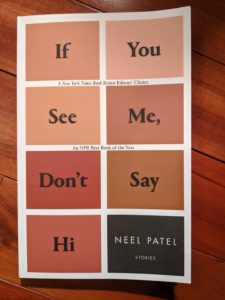 This is a stunning collection of short stories where most of the characters are first generation Indian Americans often of Gujarati heritage, like myself, straddling the line of traditional eastern values and expectations of parents with the western world they’re born into. The author strives to blow past the stereotypes that we are all simply hard working, obedient, non-sexual beings while simultaneously submersing us in taboo areas of sex, drugs, mental health, love, homosexuality, interracial relationships, divorce, not being a doctor/engineer, and singlehood. While all the stories are fiction, the “world” of each story could downright be taken out of any of the lives of the many Gujarati Indian Americans across the country today. I almost wonder whether others would get the detailed references but I really appreciate them as I would an inside joke, and it makes the stories feel all the more personal to me. I love that the author gives plenty of attention to women and gays, and also dives into areas of classism and racism. Regardless of your background, this book will tug at your emotions. If your background is similar to the author’s and my own, it’ll feel so real and personal. If you’re a first generation American coming from a traditional family, you’ll see so many parallels to your own challenges. And if you’re none of the above, it’ll be a severely eye opening look into a world we live in that many people just don’t understand. This is a quick read and so captivating that I finished it in a day. Go check it out!
This is a stunning collection of short stories where most of the characters are first generation Indian Americans often of Gujarati heritage, like myself, straddling the line of traditional eastern values and expectations of parents with the western world they’re born into. The author strives to blow past the stereotypes that we are all simply hard working, obedient, non-sexual beings while simultaneously submersing us in taboo areas of sex, drugs, mental health, love, homosexuality, interracial relationships, divorce, not being a doctor/engineer, and singlehood. While all the stories are fiction, the “world” of each story could downright be taken out of any of the lives of the many Gujarati Indian Americans across the country today. I almost wonder whether others would get the detailed references but I really appreciate them as I would an inside joke, and it makes the stories feel all the more personal to me. I love that the author gives plenty of attention to women and gays, and also dives into areas of classism and racism. Regardless of your background, this book will tug at your emotions. If your background is similar to the author’s and my own, it’ll feel so real and personal. If you’re a first generation American coming from a traditional family, you’ll see so many parallels to your own challenges. And if you’re none of the above, it’ll be a severely eye opening look into a world we live in that many people just don’t understand. This is a quick read and so captivating that I finished it in a day. Go check it out!
Amusing Ourselves to Death: Public Discourse in the Age of Show Business, by Neil Postman
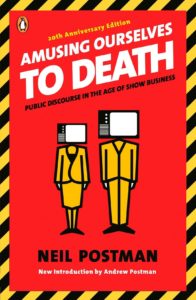 This book ought to be required reading for every person that consumes information through any sort of visual media, including social media and television. So in essence, everyone. The author discusses how the information we consume is greatly affected by the nature of the media it flows through including, oral, written, auditory, and visual forms – with a latter biasing our information to that which is more amusing, entertaining, and full of showmanship – regardless of the wholesomeness of the information. I’m sure many of you are nodding your heads with agreement upon looking at the shit show that’s become of our social media and news sources. But here’s the kicker: this book was written in 1985, and was targeted at television. The problems of visual media have been around a long time and if the author were alive today, he’d probably have an aneurism at how his arguments proved truer than he ever would have imagined. This book left a huge impression regarding how I consume information as I now check myself on whether I’m actually learning something (as opposed to having the illusion that I am) and whether the piece reeks of entertainment (hint: it likely always does). The solution of course is to move away from the fragmented, short form, and short sighted forms of information that move us from one disconnected story of the week/day/minute to another, and instead move towards long form information. Something that really astounded me was that the public debates Lincoln had with his adversaries were an all day affair, with one candidate having three hours to present points, the other another three hours, and then an hour each for rebuttals – and this wasn’t even at the presidential race level. I can’t imagine having that level of attention today, but I think it’s essential for the sanity of our society and ourselves that we move towards longer and deeper forms of information consumption. In essence this book is a testament to my own project to have books be my primary source of information. Perhaps you’re not ready for such an audacious goal, but you can start with one shorter book, and now you know just which one to choose.
This book ought to be required reading for every person that consumes information through any sort of visual media, including social media and television. So in essence, everyone. The author discusses how the information we consume is greatly affected by the nature of the media it flows through including, oral, written, auditory, and visual forms – with a latter biasing our information to that which is more amusing, entertaining, and full of showmanship – regardless of the wholesomeness of the information. I’m sure many of you are nodding your heads with agreement upon looking at the shit show that’s become of our social media and news sources. But here’s the kicker: this book was written in 1985, and was targeted at television. The problems of visual media have been around a long time and if the author were alive today, he’d probably have an aneurism at how his arguments proved truer than he ever would have imagined. This book left a huge impression regarding how I consume information as I now check myself on whether I’m actually learning something (as opposed to having the illusion that I am) and whether the piece reeks of entertainment (hint: it likely always does). The solution of course is to move away from the fragmented, short form, and short sighted forms of information that move us from one disconnected story of the week/day/minute to another, and instead move towards long form information. Something that really astounded me was that the public debates Lincoln had with his adversaries were an all day affair, with one candidate having three hours to present points, the other another three hours, and then an hour each for rebuttals – and this wasn’t even at the presidential race level. I can’t imagine having that level of attention today, but I think it’s essential for the sanity of our society and ourselves that we move towards longer and deeper forms of information consumption. In essence this book is a testament to my own project to have books be my primary source of information. Perhaps you’re not ready for such an audacious goal, but you can start with one shorter book, and now you know just which one to choose.
Gang Leader for a Day: A Rogue Sociologist Takes to the Streets, by Sudhir Venkatesh
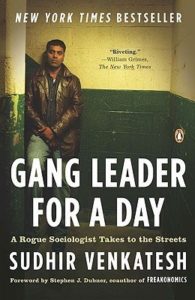 This book is super informative, engaging, and well written. The author, a South Asian, recounts his time as a graduate student of sociology and haphazardly deciding to walk into the Chicago projects to do some research, eventually becoming friends with a gang leader. Over the course of years, the author spends much of his time in this environment and learns about the lives, community, and unusual political dynamics within the public housing. The author does a great job illuminating a world that few see or can understand, and it becomes clear that the people living here are simply human beings trying to make ends meet while being in an inescapable situation that’s the result of systematic racism built into our society and government. Things that we might consider illegal (selling crack), immoral (prostitution), or corrupt (paying off government officials) are part of the daily existence, and it’s hard to blame people for resorting to these methods of madness just so they can simply exist. This book was written over a decade ago of events occurring 30 years ago, but it’s more than relevant today. Go read this book and good luck putting it down.
This book is super informative, engaging, and well written. The author, a South Asian, recounts his time as a graduate student of sociology and haphazardly deciding to walk into the Chicago projects to do some research, eventually becoming friends with a gang leader. Over the course of years, the author spends much of his time in this environment and learns about the lives, community, and unusual political dynamics within the public housing. The author does a great job illuminating a world that few see or can understand, and it becomes clear that the people living here are simply human beings trying to make ends meet while being in an inescapable situation that’s the result of systematic racism built into our society and government. Things that we might consider illegal (selling crack), immoral (prostitution), or corrupt (paying off government officials) are part of the daily existence, and it’s hard to blame people for resorting to these methods of madness just so they can simply exist. This book was written over a decade ago of events occurring 30 years ago, but it’s more than relevant today. Go read this book and good luck putting it down.
Mind and Self
What Doesn’t Kill Us: How Freezing Water, Extreme Altitude and Environmental Conditioning will Renew our Lost Evolutionary Strength, by Scott Carney
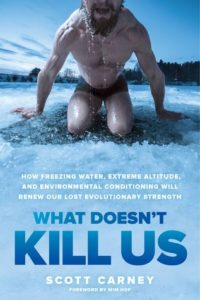 I thoroughly enjoyed this book and highly recommend it. The essence of it is that we’re pansies about the cold much because we live in a modern world where we move from one climate controlled environment to another, with minimal exposure to the real elements. The author argues that our bodies are evolutionarily designed to handle cold conditions and by letting this capability go unused, we’re developing health problems (much in the way we’ve developed autoimmune diseases by living in a sterile world). But through cold weather training, we can reactivate these systems and live a more vital life, and one where we don’t feel the pain of cold. The author himself was a skeptic of this movement and originally explored this world to debunk it, and instead became a convert. On a more personal level, this book not only confirms my own theories towards cold weather training (for years I’ve skated year round regardless of temperature and always “underdressed” to force my body to get used to it), but suggests that I can go way further. Perhaps it’s just a placebo effect, but I’ve come to embrace the cold since I began reading this book – from walking outside a minute without a shirt in NYC to going for a swim in the Miami ocean (I never swim because I get too cold), and I’m finding myself enjoying it and hardly feeling the cold. Don’t be surprised if you see me forego the shirt in general regardless of temperature 🙂 Thanks Trish for recommending this book!
I thoroughly enjoyed this book and highly recommend it. The essence of it is that we’re pansies about the cold much because we live in a modern world where we move from one climate controlled environment to another, with minimal exposure to the real elements. The author argues that our bodies are evolutionarily designed to handle cold conditions and by letting this capability go unused, we’re developing health problems (much in the way we’ve developed autoimmune diseases by living in a sterile world). But through cold weather training, we can reactivate these systems and live a more vital life, and one where we don’t feel the pain of cold. The author himself was a skeptic of this movement and originally explored this world to debunk it, and instead became a convert. On a more personal level, this book not only confirms my own theories towards cold weather training (for years I’ve skated year round regardless of temperature and always “underdressed” to force my body to get used to it), but suggests that I can go way further. Perhaps it’s just a placebo effect, but I’ve come to embrace the cold since I began reading this book – from walking outside a minute without a shirt in NYC to going for a swim in the Miami ocean (I never swim because I get too cold), and I’m finding myself enjoying it and hardly feeling the cold. Don’t be surprised if you see me forego the shirt in general regardless of temperature 🙂 Thanks Trish for recommending this book!
Freedom from the Known, by Jiddu Krishnamurti
 I became aware of this Indian philosopher when, in another book, he was quoted: “It is no measure of health to be well adjusted to a profoundly sick society.” Seemed like my kind of thing, and this book very much is. The author argues that we seek a freedom from conflict in the mind by following the external: like society’s rules, religion, schools of thought, and drugs; yet this freedom can only come from within ourselves as we must be our own teacher and our own disciple. There’s a lot of interesting angles he approaches, and they’re all interrelated. For example: that we often don’t actually have relationships with people, but instead with our images of them. And that a lot of the conflict in the mind comes from it “living” in the past or future, when we’re only really capable of living in the present. This is a very welcome read as I’ve already been in the midst of considering these principles throughout my daily life, and the book showed that I’m still very much in conflict in my mind.
I became aware of this Indian philosopher when, in another book, he was quoted: “It is no measure of health to be well adjusted to a profoundly sick society.” Seemed like my kind of thing, and this book very much is. The author argues that we seek a freedom from conflict in the mind by following the external: like society’s rules, religion, schools of thought, and drugs; yet this freedom can only come from within ourselves as we must be our own teacher and our own disciple. There’s a lot of interesting angles he approaches, and they’re all interrelated. For example: that we often don’t actually have relationships with people, but instead with our images of them. And that a lot of the conflict in the mind comes from it “living” in the past or future, when we’re only really capable of living in the present. This is a very welcome read as I’ve already been in the midst of considering these principles throughout my daily life, and the book showed that I’m still very much in conflict in my mind.
The Four Agreements: A Practical Guide to Personal Freedom, by Miguel Ruiz
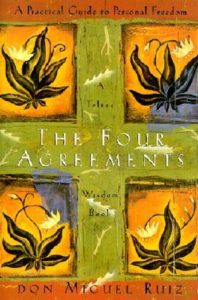 This book is short yet full of terrific perspective about the external forces (primarily perceived forces of society) that cause us to make choices to live a certain manner that ultimate restricts us. I like that the author is direct about the matter – saying that we are domesticated (a theme that fits well with my own take of the world). He proposes four specific “agreements”, pacts we make with ourselves, which can help us mitigate and even eliminate the impact of these external forces and instead allow us to live vital, open, and effective lives. The insights go beyond these four agreements and at points I had to put down the book and think about the implications of them on my own life. It was terrifying in one way and freeing in another to see aspects of my life arc through these new lenses. This is an awesome read and I highly recommend it.
This book is short yet full of terrific perspective about the external forces (primarily perceived forces of society) that cause us to make choices to live a certain manner that ultimate restricts us. I like that the author is direct about the matter – saying that we are domesticated (a theme that fits well with my own take of the world). He proposes four specific “agreements”, pacts we make with ourselves, which can help us mitigate and even eliminate the impact of these external forces and instead allow us to live vital, open, and effective lives. The insights go beyond these four agreements and at points I had to put down the book and think about the implications of them on my own life. It was terrifying in one way and freeing in another to see aspects of my life arc through these new lenses. This is an awesome read and I highly recommend it.
Zen in the Martial Arts, by Joe Hyams
 This is a great quick read and one I’d first read many years ago as a young adult when I’d gotten back into the martial arts. The author captures insightful anecdotes and stories from martial arts masters he trained under, including Bruce Lee. These lessons are awesomely practical because they apply not only to martial arts, but to all sorts of life circumstances. I own a physical copy, given to me by a friend, so hit me up if you’d like to borrow it.
This is a great quick read and one I’d first read many years ago as a young adult when I’d gotten back into the martial arts. The author captures insightful anecdotes and stories from martial arts masters he trained under, including Bruce Lee. These lessons are awesomely practical because they apply not only to martial arts, but to all sorts of life circumstances. I own a physical copy, given to me by a friend, so hit me up if you’d like to borrow it.
Ego Is the Enemy, by Ryan Holiday (audiobook version)
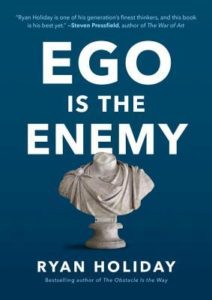 We all got ego and at some point in our lives, or more likely many points, it has kept us from being our very best selves. This book consists mostly of stories of individuals with ego, and those that have transcended ego, to illustrate the impact it has on our own happiness and success. The author delves into his own stories as well. I found the piece to be especially relevant to today’s world, where we’re so keen to push forth our own specialness despite the obvious and not so obvious repercussions. It’s also been really insightful for me as I’ve worked for many years to address my own presence of ego, and continue to do so still.
We all got ego and at some point in our lives, or more likely many points, it has kept us from being our very best selves. This book consists mostly of stories of individuals with ego, and those that have transcended ego, to illustrate the impact it has on our own happiness and success. The author delves into his own stories as well. I found the piece to be especially relevant to today’s world, where we’re so keen to push forth our own specialness despite the obvious and not so obvious repercussions. It’s also been really insightful for me as I’ve worked for many years to address my own presence of ego, and continue to do so still.
The Art of Stillness: Adventures in Going Nowhere, by Pico Iyer
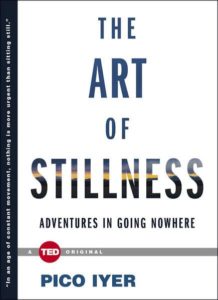 This is a super short read, but offers some thoughts on the experience in a mode of nothingness, something quite rare in our always-on modern world. He shares stories of some specific individuals that have chosen this mode and the different ways they go about it – from the extreme of isolated zen monasteries in the mountains to simply alone time during a drive. One interesting point shows how those most infused in our tech heavy world tend ones proactively creating “sabbaths” to disconnect from it.
This is a super short read, but offers some thoughts on the experience in a mode of nothingness, something quite rare in our always-on modern world. He shares stories of some specific individuals that have chosen this mode and the different ways they go about it – from the extreme of isolated zen monasteries in the mountains to simply alone time during a drive. One interesting point shows how those most infused in our tech heavy world tend ones proactively creating “sabbaths” to disconnect from it.
How Will You Measure Your Life? by Clayton M. Christensen, James Allworth, and Karen Dillon
 I found the title of this book a bit unusual, as the content is so much more. The authors discuss strategies and anecdotes to living a meaningful life and given that the authors come from the business world, they offer many interesting and well fitting parallels and stories between that world and that which pertains to our lives. One major area covered includes principles for creating a career that brings purpose, balance, and meaning. Another area explored values to forming intimate relationships and raising children, which I found very well stated. The last section was on living a life of integrity. Overall this book is well organized, easy to read, and full of interesting insights that one can immediately apply to their own lives.
I found the title of this book a bit unusual, as the content is so much more. The authors discuss strategies and anecdotes to living a meaningful life and given that the authors come from the business world, they offer many interesting and well fitting parallels and stories between that world and that which pertains to our lives. One major area covered includes principles for creating a career that brings purpose, balance, and meaning. Another area explored values to forming intimate relationships and raising children, which I found very well stated. The last section was on living a life of integrity. Overall this book is well organized, easy to read, and full of interesting insights that one can immediately apply to their own lives.
Who Are You, Really?: The Surprising Puzzle of Personality, by Brian R. Little
 This is a short book that appears to be based on a TED talk, and to be honest, the TED talk probably would have sufficed for the content presented. The author discusses that our personality is formed not only from nature (which he bases on openness, conscientiousness, extraversion, agreeableness, and neuroticism) and nurture (our societal forces and opportunities), but also the “projects” that we pursue. These projects can represent nearly anything including paid work, finding a mate, cooking a meal, or going on a trip. In essence, the author argues that who we are doesn’t determine what projects we pursue, but that the projects we pursue determine who we are, even overriding our nature and nurture.
This is a short book that appears to be based on a TED talk, and to be honest, the TED talk probably would have sufficed for the content presented. The author discusses that our personality is formed not only from nature (which he bases on openness, conscientiousness, extraversion, agreeableness, and neuroticism) and nurture (our societal forces and opportunities), but also the “projects” that we pursue. These projects can represent nearly anything including paid work, finding a mate, cooking a meal, or going on a trip. In essence, the author argues that who we are doesn’t determine what projects we pursue, but that the projects we pursue determine who we are, even overriding our nature and nurture.When Things Fall Apart: Heart Advice For Difficult Times, by Pema Chödrön
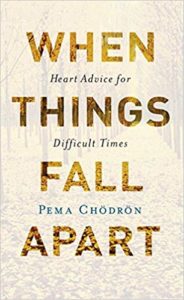 This is a relatively short read that has a handful of useful insights, but overall falls pretty flat. The whole thing could be summarized as “when things fall apart, run towards instead of away”. The author speaks in very abstract terms and jumps between concepts, anecdotes, stories, and her own experiences. This would normally be fine, except there appears to be little connection between these parts and it often comes off as incoherent rambling. As mentioned, there are some good insights hidden within the text, but they barely receive any attention, elaboration, or concrete examples. As I was mostly through this book and still bewildered about what the author was getting at, I decided to look her up. Turns out she’s one of these American born white women that fell into the hippie Eastern mysticism craze common in the Bay Area (she did study at UC Berkeley), went off to find her South Asian guru, got herself a new Eastern name, and now speaks in riddles. If there’s any familiarity to her style, it’s that of the white people that like leading yoga classes while thoroughly mispronouncing foreign words and concepts and giving the impression that they’re some sort of sacred vessel here to enlighten us. That said, if you’re one of those froo froo hippie types (nothing against them, as I have many friends that are), you might enjoy this work and find it useful. But as someone that comes from an Eastern culture and prefers something more down to Earth and concrete, it wasn’t a well suited read for me.
This is a relatively short read that has a handful of useful insights, but overall falls pretty flat. The whole thing could be summarized as “when things fall apart, run towards instead of away”. The author speaks in very abstract terms and jumps between concepts, anecdotes, stories, and her own experiences. This would normally be fine, except there appears to be little connection between these parts and it often comes off as incoherent rambling. As mentioned, there are some good insights hidden within the text, but they barely receive any attention, elaboration, or concrete examples. As I was mostly through this book and still bewildered about what the author was getting at, I decided to look her up. Turns out she’s one of these American born white women that fell into the hippie Eastern mysticism craze common in the Bay Area (she did study at UC Berkeley), went off to find her South Asian guru, got herself a new Eastern name, and now speaks in riddles. If there’s any familiarity to her style, it’s that of the white people that like leading yoga classes while thoroughly mispronouncing foreign words and concepts and giving the impression that they’re some sort of sacred vessel here to enlighten us. That said, if you’re one of those froo froo hippie types (nothing against them, as I have many friends that are), you might enjoy this work and find it useful. But as someone that comes from an Eastern culture and prefers something more down to Earth and concrete, it wasn’t a well suited read for me.
The Life-Changing Magic of Tidying Up: The Japanese Art of Decluttering and Organizing, by Marie Kondo
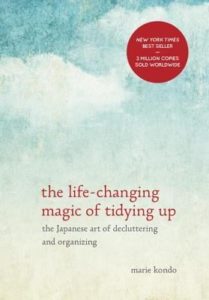 Written by perhaps the world’s most famous tidy upper, this short piece offers us the strategies and philosophies to cleaning up our homes. The core of the book drives home two strategies – disposing possessions and creating a place for remaining possessions – and the author argues that doing these two things correctly will void the need for any other strategy. She goes into meticulous detail on how these two strategies must be applied (and the magic is in these details) and warns against sophisticated storage systems as they don’t actually address the root problem of having too much stuff. The real gem of this book though is not the strategies, but the philosophies within the details and the bigger picture, as they not only have a spiritual feel, but are also practical. For example, the author says that one needs to hold each item when sorting and ask whether the item brings them joy, and use that as the primary metric for deciding whether to keep something. Conversely, the author points out that the process of decluttering brings one insights into their true interests and desires. There’s so much more than this but I won’t spoil the surprises. Definitely check out this book.
Written by perhaps the world’s most famous tidy upper, this short piece offers us the strategies and philosophies to cleaning up our homes. The core of the book drives home two strategies – disposing possessions and creating a place for remaining possessions – and the author argues that doing these two things correctly will void the need for any other strategy. She goes into meticulous detail on how these two strategies must be applied (and the magic is in these details) and warns against sophisticated storage systems as they don’t actually address the root problem of having too much stuff. The real gem of this book though is not the strategies, but the philosophies within the details and the bigger picture, as they not only have a spiritual feel, but are also practical. For example, the author says that one needs to hold each item when sorting and ask whether the item brings them joy, and use that as the primary metric for deciding whether to keep something. Conversely, the author points out that the process of decluttering brings one insights into their true interests and desires. There’s so much more than this but I won’t spoil the surprises. Definitely check out this book.
Society
Going Gray: What I Learned about Beauty, Sex, Work, Motherhood, Authenticity, and Everything Else That Really Matters, by Anne Kreamer
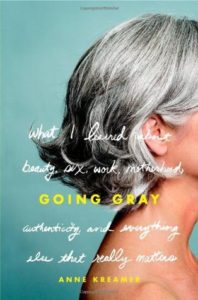 I had the awesome opportunity to meet the author at an artists’ retreat in Italy and decided to pick up her book to explore the biases, within society and myself, regarding expectations of women’s appearance. A few things became very apparent to me: that women start to go gray much earlier than I expected (usually in their 30s and sometimes even in their 20s), and that nearly every woman colors their hair (a process that’s expensive in time and money). The piece is pretty riveting as the author presents an honest and vulnerable look at her own process of stopping to color her hair, and weaves in tons of personal firsthand research – from experiments in online dating to visiting appearance consultants for professional makeovers. It’s a rather brave story because although it seems like a piece that’d be relevant with the surge of women’s power pieces going strong today, the book was released over ten years ago and accounted for events happening in years prior. This work is full of surprises as it reveals that having gray hair as a woman appears to be considered attractive to men but also a detriment within the domain of many careers choices. I also found it fascinating that the author shares the great deal of the insecurity she felt about herself and the process, which is in stark contrast to the confident and accomplished woman that I met – complete with a shock of gray hair. Perhaps it was the process she went though. Either way, this book has changed the way I look at gray, and I highly recommend it.
I had the awesome opportunity to meet the author at an artists’ retreat in Italy and decided to pick up her book to explore the biases, within society and myself, regarding expectations of women’s appearance. A few things became very apparent to me: that women start to go gray much earlier than I expected (usually in their 30s and sometimes even in their 20s), and that nearly every woman colors their hair (a process that’s expensive in time and money). The piece is pretty riveting as the author presents an honest and vulnerable look at her own process of stopping to color her hair, and weaves in tons of personal firsthand research – from experiments in online dating to visiting appearance consultants for professional makeovers. It’s a rather brave story because although it seems like a piece that’d be relevant with the surge of women’s power pieces going strong today, the book was released over ten years ago and accounted for events happening in years prior. This work is full of surprises as it reveals that having gray hair as a woman appears to be considered attractive to men but also a detriment within the domain of many careers choices. I also found it fascinating that the author shares the great deal of the insecurity she felt about herself and the process, which is in stark contrast to the confident and accomplished woman that I met – complete with a shock of gray hair. Perhaps it was the process she went though. Either way, this book has changed the way I look at gray, and I highly recommend it.
The God of Small Things, by Arundhati Roy
 I read this novel back in high school, but remember little of it. Reading it again I can see why as I was much too naive to understand the unsavory themes that the story dives into. The novel centers on a two twin siblings and events that transpired during two particular time periods in India. The novel feels almost like a mystery as the author jumps back and forth between these two time periods setting the stage and slowly revealing pieces of the puzzle. Throughout the story we’re exposed to themes of colonialism, racism, mixed races, classism, domestic abuse, child molestation, classism, politics, family image, and love. What I especially like is that this piece is written in a way that mimics the stream of consciousness of a child – interpreting happenings and even language in an ultra creative and often silly seeming manner.
I read this novel back in high school, but remember little of it. Reading it again I can see why as I was much too naive to understand the unsavory themes that the story dives into. The novel centers on a two twin siblings and events that transpired during two particular time periods in India. The novel feels almost like a mystery as the author jumps back and forth between these two time periods setting the stage and slowly revealing pieces of the puzzle. Throughout the story we’re exposed to themes of colonialism, racism, mixed races, classism, domestic abuse, child molestation, classism, politics, family image, and love. What I especially like is that this piece is written in a way that mimics the stream of consciousness of a child – interpreting happenings and even language in an ultra creative and often silly seeming manner.
The Outsourced Self: What Happens When We Pay Others to Live Our Lives for Us, by Arlie Russell Hochschild
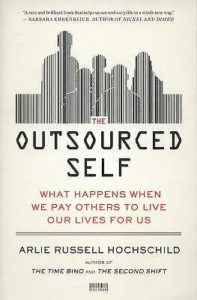 This was a cool read that delved into the a number of ways that we now “outsource” rather intimate aspects of our lives. The areas includes dating (now online and with with online dating coaches), wedding planning, raising kids, and parental caregiving, to name a few. While I expected the author to come off judgmental towards these trends, she was actually very objective about the tradeoffs that we experience, and that we do live in a new reality these days. I was especially stirred by her two chapters on surrogate mother businesses run in India (with “clients” worldwide) as the author devoted not only a chapter for the outsourcer’s perspective, but one for that of the surrogates. There’s some room for critique though. For one, some of the chapters seem more about rich people problems which I have little sympathy for, though the author does do a good job exploring the impact on the not so rich people outsourced to deal with problems. And secondly, the author attempts to weave together her disparate chapters with a personal story of her aunt who needs taking care of, but this insertion seems rather forced and I feel it weakens her piece. Overall though, the research is deep, the material is fantastic, and the book is well worth a read.
This was a cool read that delved into the a number of ways that we now “outsource” rather intimate aspects of our lives. The areas includes dating (now online and with with online dating coaches), wedding planning, raising kids, and parental caregiving, to name a few. While I expected the author to come off judgmental towards these trends, she was actually very objective about the tradeoffs that we experience, and that we do live in a new reality these days. I was especially stirred by her two chapters on surrogate mother businesses run in India (with “clients” worldwide) as the author devoted not only a chapter for the outsourcer’s perspective, but one for that of the surrogates. There’s some room for critique though. For one, some of the chapters seem more about rich people problems which I have little sympathy for, though the author does do a good job exploring the impact on the not so rich people outsourced to deal with problems. And secondly, the author attempts to weave together her disparate chapters with a personal story of her aunt who needs taking care of, but this insertion seems rather forced and I feel it weakens her piece. Overall though, the research is deep, the material is fantastic, and the book is well worth a read.
The Infinite Game, by Simon Sinek (audiobook version)
 This author has played a role in my holding onto my spirit while navigating the dispiriting world of work through his books and talks, so I was excited to see another piece from him. Here, the author discusses strategies concerning work, projects, interpersonal relationships, and everything in between through the lens of whether we’re playing as if it is a finite “game” or an infinite one. He defines the former as something with fixed rules, knowns, and a defined ending (much like all sports), while the latter is full of unknowns, potential chaos, and has no defined ending. The author states that we often mistakenly apply a finite mindset to the infinite nature of the work world and while this often produces short term benefits, it doesn’t bode well for the long run. What I especially appreciate is that he calls out the bullshit where most companies claim to be infinitely minded (“serve the health of our customers” in the case of a convenience store chain) while pursuing actions that contradict the very value (selling cigarettes and saying they’re “evaluating” things when being called out). The author also points out how such finite thinking leads to something he calls “ethical fading”, where values and ethics slide down a slippery slope because of the arrangement of incentives – something I believe most people have experienced working for any kind of organization. I found it interesting that a lot of the companies that were shown to have issues with finite thinking were affected by their shareholders and the short sighted stock system. This piece overall is great and engaging and I recommend it to everyone looking to regain some spirit in their work. And I’d consider this required reading for anyone that runs any type of organization. The audiobook version is read by the author so it’s worth considering that version.
This author has played a role in my holding onto my spirit while navigating the dispiriting world of work through his books and talks, so I was excited to see another piece from him. Here, the author discusses strategies concerning work, projects, interpersonal relationships, and everything in between through the lens of whether we’re playing as if it is a finite “game” or an infinite one. He defines the former as something with fixed rules, knowns, and a defined ending (much like all sports), while the latter is full of unknowns, potential chaos, and has no defined ending. The author states that we often mistakenly apply a finite mindset to the infinite nature of the work world and while this often produces short term benefits, it doesn’t bode well for the long run. What I especially appreciate is that he calls out the bullshit where most companies claim to be infinitely minded (“serve the health of our customers” in the case of a convenience store chain) while pursuing actions that contradict the very value (selling cigarettes and saying they’re “evaluating” things when being called out). The author also points out how such finite thinking leads to something he calls “ethical fading”, where values and ethics slide down a slippery slope because of the arrangement of incentives – something I believe most people have experienced working for any kind of organization. I found it interesting that a lot of the companies that were shown to have issues with finite thinking were affected by their shareholders and the short sighted stock system. This piece overall is great and engaging and I recommend it to everyone looking to regain some spirit in their work. And I’d consider this required reading for anyone that runs any type of organization. The audiobook version is read by the author so it’s worth considering that version.
When Strangers Meet: How People You Don’t Know Can Transform You, by Kio Stark
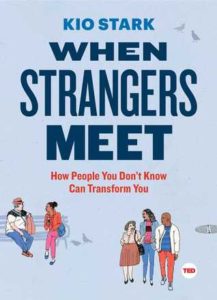 This is a fun little read about the magic that’s possible when you’re willing to pierce through the wall of anonymity, especially the sort that exists in a place like New York City. In addition to enjoyable tales, the author provides a bunch of practical tips to help one engage with strangers. For a super shy person such as myself, it’s definitely a different manner of thinking and one that I expect to take me on new adventures, in both the mental and physical worlds.
This is a fun little read about the magic that’s possible when you’re willing to pierce through the wall of anonymity, especially the sort that exists in a place like New York City. In addition to enjoyable tales, the author provides a bunch of practical tips to help one engage with strangers. For a super shy person such as myself, it’s definitely a different manner of thinking and one that I expect to take me on new adventures, in both the mental and physical worlds.
Sapiens: A Brief History of Humankind, by Yuval Noah Harari (audiobook version)
 This is a substantial book and one that seems to be making rounds recently, but I have mixed feelings about it. The author does a great job explaining principles of evolution and the scientific process by which we can decipher our history, and in an easy to understand manner. He also proposes all sorts of interesting philosophical discussion and ideas about aspects of our human history and humanity’s future. On the split side, many of his claims are misguided, according to research in the field I’ve worked with or done firsthand myself. For example, the author claims that much of humanity’s uniqueness and adeptness at cooperating at large scales stems from our ability to hold and believe in shared imagined concepts (like laws and political beliefs). While there’s some truth to this, it misses the next level of explanation which is that our real unique ability is to enforce (through threat of force) sets of shared rules (which can take the form of imagined concepts) and that’s what ultimately promotes cooperation at scale. This goes double for the author’s huge chapter on religious belief, where he argues that the beliefs themselves are what created the power of religions. This was specifically my research area and the work I did shows that humans evolved religious concepts as part of a larger in-group out-group dynamic, and these concepts were later hijacked by those in power (those with threat of force) in order to promote their agendas. That said, this was still an enjoyable and well written read and I recommend it. Just take all the claims with a grain of salt.
This is a substantial book and one that seems to be making rounds recently, but I have mixed feelings about it. The author does a great job explaining principles of evolution and the scientific process by which we can decipher our history, and in an easy to understand manner. He also proposes all sorts of interesting philosophical discussion and ideas about aspects of our human history and humanity’s future. On the split side, many of his claims are misguided, according to research in the field I’ve worked with or done firsthand myself. For example, the author claims that much of humanity’s uniqueness and adeptness at cooperating at large scales stems from our ability to hold and believe in shared imagined concepts (like laws and political beliefs). While there’s some truth to this, it misses the next level of explanation which is that our real unique ability is to enforce (through threat of force) sets of shared rules (which can take the form of imagined concepts) and that’s what ultimately promotes cooperation at scale. This goes double for the author’s huge chapter on religious belief, where he argues that the beliefs themselves are what created the power of religions. This was specifically my research area and the work I did shows that humans evolved religious concepts as part of a larger in-group out-group dynamic, and these concepts were later hijacked by those in power (those with threat of force) in order to promote their agendas. That said, this was still an enjoyable and well written read and I recommend it. Just take all the claims with a grain of salt.
If you’ve read this book or are interested in the topic of human history, I highly recommend the book written by my research professors: Death from a Distance and the Birth of a Humane Universe: Human Evolution, Behavior, History, and Your Future, by Paul M. Bingham and Joanne Souza. And yes, it does include some of my research work.
Everything is F*cked: A Book About Hope, by Mark Manson (audiobook version)
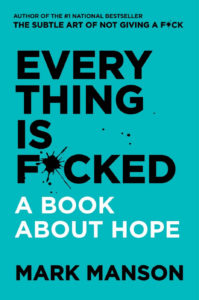 Riding off the coattails of the ever popular “The Subtle Art of Not Giving a F*ck”, this book looks into the supposed grim seeming world we’re living in today. The author discusses the paradox of how there’s a general sense of anxiety permeating society despite the fact that things are materially better than ever before. He delves into plenty of psychological research and philosophy to illustrate that we’re often chasing the wrong things to ease our anxiety, and that there’s certain aspects of our humanity we must understand and accept in order to escape this everything is fucked mindset. This piece is as entertaining as it is informative and as with the author’s previous book, I recommend the audiobook version and it is delightfully read by the author himself.
Riding off the coattails of the ever popular “The Subtle Art of Not Giving a F*ck”, this book looks into the supposed grim seeming world we’re living in today. The author discusses the paradox of how there’s a general sense of anxiety permeating society despite the fact that things are materially better than ever before. He delves into plenty of psychological research and philosophy to illustrate that we’re often chasing the wrong things to ease our anxiety, and that there’s certain aspects of our humanity we must understand and accept in order to escape this everything is fucked mindset. This piece is as entertaining as it is informative and as with the author’s previous book, I recommend the audiobook version and it is delightfully read by the author himself.
NeuroTribes: The Legacy of Autism and the Future of Neurodiversity, by Steve Silberman (audiobook version)
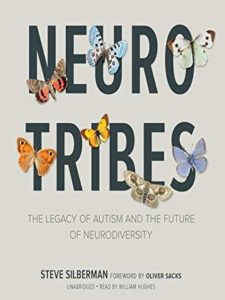 This was a very long book but covered a great deal more than I expected. There’s so much to autism in form, history, and misconception and the author does a great job exploring each of these areas. One point is that autism takes many form (best described as a multidimensional spectrum), and while those with autism deal with many challenges (e.g. overstimulation), many also exhibit some pretty stunning capabilities (e.g. in technical fields like engineering). Something unexpected is the author’s deep dive on the history of treatment (especially mistreatment) of those with mental challenges, and how autistic individuals have been unfortunately and callously intertwined with those that exhibited mental or physiological conditions. That part seemed overdone to me but overall the information in book is solid.
This was a very long book but covered a great deal more than I expected. There’s so much to autism in form, history, and misconception and the author does a great job exploring each of these areas. One point is that autism takes many form (best described as a multidimensional spectrum), and while those with autism deal with many challenges (e.g. overstimulation), many also exhibit some pretty stunning capabilities (e.g. in technical fields like engineering). Something unexpected is the author’s deep dive on the history of treatment (especially mistreatment) of those with mental challenges, and how autistic individuals have been unfortunately and callously intertwined with those that exhibited mental or physiological conditions. That part seemed overdone to me but overall the information in book is solid.
Originals: How Non-Conformists Move the World, by Adam M. Grant (audiobook version)
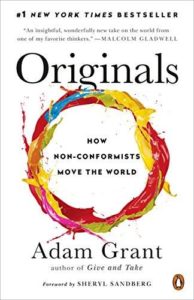 Although, the title of this book is inaccurate and the splattering of info makes it hard to get a solid structure for this piece, the content presented is marvelous. The author does a good job finding various patterns that show how one can indeed make an impact on the world. He presents all sorts of examples including the women’s suffrage movement, the success of Warby Parker, the failure of the Segway, and the takedown of a Serbian dictator. Through these stories are interesting and surprising patterns and insights like how risk takers are less likely to be succeed in a new endeavor than the risk averse, how procrastination aids the creative process, and how pitching your flaws is more likely to get a sell.
Although, the title of this book is inaccurate and the splattering of info makes it hard to get a solid structure for this piece, the content presented is marvelous. The author does a good job finding various patterns that show how one can indeed make an impact on the world. He presents all sorts of examples including the women’s suffrage movement, the success of Warby Parker, the failure of the Segway, and the takedown of a Serbian dictator. Through these stories are interesting and surprising patterns and insights like how risk takers are less likely to be succeed in a new endeavor than the risk averse, how procrastination aids the creative process, and how pitching your flaws is more likely to get a sell.
Deep Nutrition: Why Your Genes Need Traditional Food, by Catherine Shanahan
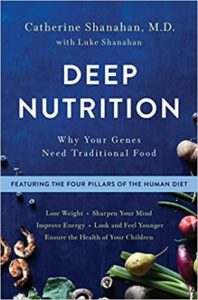 I’ve read a good fifteen or so books over the years on the topic of food, nutrition, and the science, history, and poltiics behind it. This book was great in that it was consistent with the primary pattern I’ve found in these books on food (healthfulness is inversely proportional to the level of processing the “food” has undergone). Better yet, the author, a biochemist and unorthodox doctor, offered many new insights in concert with the theme. She argues and provides research supporting the highly detrimental effects of two items in our food world: one being the obvious culprit of sugar and the other being vegetable oil, a much less obvious one that appears to be in pretty much everything. And central to her concept of a healthful diet are four pillars that appear to be present in many traditional diets: fresh food, fermented and sprouted food, organ meats (and eggs), and meat cooked on the bone, and reasons for why each provides such health benefits. The content of this book is great, and even includes some interesting chapters on creating healthy children. Overall the book does feel long and repetitive at times, so something to keep in mind.
I’ve read a good fifteen or so books over the years on the topic of food, nutrition, and the science, history, and poltiics behind it. This book was great in that it was consistent with the primary pattern I’ve found in these books on food (healthfulness is inversely proportional to the level of processing the “food” has undergone). Better yet, the author, a biochemist and unorthodox doctor, offered many new insights in concert with the theme. She argues and provides research supporting the highly detrimental effects of two items in our food world: one being the obvious culprit of sugar and the other being vegetable oil, a much less obvious one that appears to be in pretty much everything. And central to her concept of a healthful diet are four pillars that appear to be present in many traditional diets: fresh food, fermented and sprouted food, organ meats (and eggs), and meat cooked on the bone, and reasons for why each provides such health benefits. The content of this book is great, and even includes some interesting chapters on creating healthy children. Overall the book does feel long and repetitive at times, so something to keep in mind.
Antifragile: Things That Gain from Disorder, by Nassim Nicholas Taleb (audiobook version)
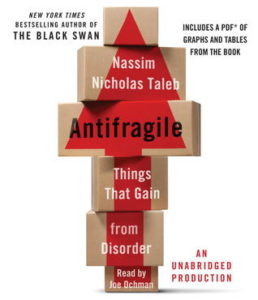 This might be one of the most insightful pieces I’ve picked up. The author talks about a general property that some things may have , “antifragility”, which is something that not only survives a stressful environment, but thrives and benefits from it. These “things” could be literally anything, like ideas, systems (natural and manmade), and even romantic relationships. Concordantly, the author applies his principles across utterly different domains, including financial strategy, maintaining good health, the restaurant industry, and a very astute explanation for organisms evolving the ability to die. What I especially like about the author is that he freely speaks what he thinks (he does argue that one should speak no differently between being sober and having two glasses of wine – something I agree with) so he’s slamming people left and right, most notably the so called intellectuals across academia, business, and politics which he sees more as bureaucrats and double speakers. I have to admit though that it does seem a bit much, as the author often sounds like he’s butthurt and defensive – quite a shame as his totally insights stand on their own. That said, the ratio of insight to ranting is pretty good, and substantially better than another book I’ve read from the author, “Skin in the Game”. Check out this book and you will never see the world the same!
This might be one of the most insightful pieces I’ve picked up. The author talks about a general property that some things may have , “antifragility”, which is something that not only survives a stressful environment, but thrives and benefits from it. These “things” could be literally anything, like ideas, systems (natural and manmade), and even romantic relationships. Concordantly, the author applies his principles across utterly different domains, including financial strategy, maintaining good health, the restaurant industry, and a very astute explanation for organisms evolving the ability to die. What I especially like about the author is that he freely speaks what he thinks (he does argue that one should speak no differently between being sober and having two glasses of wine – something I agree with) so he’s slamming people left and right, most notably the so called intellectuals across academia, business, and politics which he sees more as bureaucrats and double speakers. I have to admit though that it does seem a bit much, as the author often sounds like he’s butthurt and defensive – quite a shame as his totally insights stand on their own. That said, the ratio of insight to ranting is pretty good, and substantially better than another book I’ve read from the author, “Skin in the Game”. Check out this book and you will never see the world the same!
The Windup Girl, by Paolo Bacigalupi
 An incredible novel set in a not so distant future Thailand and one that can’t quite be classified as it has elements of extrapolative fiction, science fiction, and dystopian future. The author did a terrific job with not only the world in which the story exists, but especially so with character development, with a focus on moral ambiguity so you don’t quite know who to root for or against. If you’re on the empathetic side, as I am, be warned that you’ll have your emotions tugged in all sorts of places because you’ll really feel for the characters and their difficult circumstances. Although the book was written ten years ago, it has a lot of relevance today in the areas of genetic engineering, global politics and trade, race relations, and corporate influence. And I imagine it’ll play a greater relevance as our real world future unfolds. Thanks Stephen for recommending this book!
An incredible novel set in a not so distant future Thailand and one that can’t quite be classified as it has elements of extrapolative fiction, science fiction, and dystopian future. The author did a terrific job with not only the world in which the story exists, but especially so with character development, with a focus on moral ambiguity so you don’t quite know who to root for or against. If you’re on the empathetic side, as I am, be warned that you’ll have your emotions tugged in all sorts of places because you’ll really feel for the characters and their difficult circumstances. Although the book was written ten years ago, it has a lot of relevance today in the areas of genetic engineering, global politics and trade, race relations, and corporate influence. And I imagine it’ll play a greater relevance as our real world future unfolds. Thanks Stephen for recommending this book!
Lost Connections: Uncovering the Real Causes of Depression – and the Unexpected Solutions, by Johann Hari
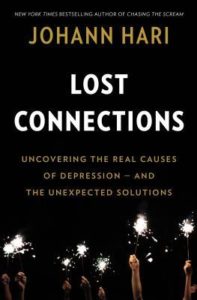 The author argues that depression (and the anxiety that often accompanies it) stems rarely from biological causes which is the narrative that our medical industry pushes, but instead mostly from societal factors, primarily losing connections with people, work, and values. He goes through specific factors that influence someone becoming depressed and how the way we live in our modern society pushes this likelihood. There’s some surprising insights, like how ubiquitous advertising affects us from a young age to how technology is not so much a cause of people losing connections, but a symptom of it instead. The implications reach beyond our individual approach to address depression, and indicate that there’s something very insidious in our modern social lives that we need to take heed to. I highly recommend this book and digital versions are available for dirt cheap ($2 eBook, $7.50 audio book).
The author argues that depression (and the anxiety that often accompanies it) stems rarely from biological causes which is the narrative that our medical industry pushes, but instead mostly from societal factors, primarily losing connections with people, work, and values. He goes through specific factors that influence someone becoming depressed and how the way we live in our modern society pushes this likelihood. There’s some surprising insights, like how ubiquitous advertising affects us from a young age to how technology is not so much a cause of people losing connections, but a symptom of it instead. The implications reach beyond our individual approach to address depression, and indicate that there’s something very insidious in our modern social lives that we need to take heed to. I highly recommend this book and digital versions are available for dirt cheap ($2 eBook, $7.50 audio book).
How to Raise Successful People: Simple Lessons for Radical Results, by Esther Wojcicki (audiobook version)
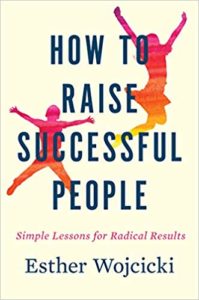 This is a terrific piece that simply put, brushes aside the all too common helicopter parenting trend that’s produced a generation that hardly seems to be able to do anything for themselves, and instead focuses on creating an environment that helps children and teenagers develop into stunningly independent and capable individuals. The author is the mother of three of the world’s most accomplished women: the head of YouTube, the founder of 23andMe, and a professor of pediatrics. I began reading this book with a bit of skepticism as oftentimes success is simply masked privilege but it turns out the author herself lived a very challenging early life in a downright authoritarian household as the daughter of traditional immigrant parents that had to work hard to make ends meet – something I can very much relate to. The author discusses her framework which consists of five components: trust, respect, independence, collaboration, and kindness (TRICK), and supports them with tons of stories and anecdotes from her own childhood, the raising of her kids, and the thousands of high school students she taught and mentored over the years. The essential principle is creating a structure for young individuals to do things on their own and often fail, but still have support throughout the process. Some of my favorite examples include letting kids decorate their own rooms (along with the outlandish style they’d have to live with for years), debating whether and how to go about including a difficult topic in a school newspaper (along with the implications it has on various individuals and themselves), and being included in the family vacation planning (with zero complaints that they’re bored come vacation time). There’s also plenty of critique of our current world which forces young individuals to adopt a mindset of always being perfect and at the top while continuously testing them, instead of permitting mistakes that one can learn from, get feedback on, and grow. I wholeheartedly agree with all this given what I’ve experienced in my own life (sadly feeling the need to be perfect) and find myself instead using “TRICK” principles more so these days and expect to down the line. This book is as engaging as it is practical as it’s chock full of interesting and personal stories, many imparting their point in an entertaining manner. I highly recommend it to anyone that has kids, is considering having kids, or is working with young individuals.
This is a terrific piece that simply put, brushes aside the all too common helicopter parenting trend that’s produced a generation that hardly seems to be able to do anything for themselves, and instead focuses on creating an environment that helps children and teenagers develop into stunningly independent and capable individuals. The author is the mother of three of the world’s most accomplished women: the head of YouTube, the founder of 23andMe, and a professor of pediatrics. I began reading this book with a bit of skepticism as oftentimes success is simply masked privilege but it turns out the author herself lived a very challenging early life in a downright authoritarian household as the daughter of traditional immigrant parents that had to work hard to make ends meet – something I can very much relate to. The author discusses her framework which consists of five components: trust, respect, independence, collaboration, and kindness (TRICK), and supports them with tons of stories and anecdotes from her own childhood, the raising of her kids, and the thousands of high school students she taught and mentored over the years. The essential principle is creating a structure for young individuals to do things on their own and often fail, but still have support throughout the process. Some of my favorite examples include letting kids decorate their own rooms (along with the outlandish style they’d have to live with for years), debating whether and how to go about including a difficult topic in a school newspaper (along with the implications it has on various individuals and themselves), and being included in the family vacation planning (with zero complaints that they’re bored come vacation time). There’s also plenty of critique of our current world which forces young individuals to adopt a mindset of always being perfect and at the top while continuously testing them, instead of permitting mistakes that one can learn from, get feedback on, and grow. I wholeheartedly agree with all this given what I’ve experienced in my own life (sadly feeling the need to be perfect) and find myself instead using “TRICK” principles more so these days and expect to down the line. This book is as engaging as it is practical as it’s chock full of interesting and personal stories, many imparting their point in an entertaining manner. I highly recommend it to anyone that has kids, is considering having kids, or is working with young individuals.
Relationships
The Five Love Languages: How to Express Heartfelt Commitment to Your Mate, by Gary Chapman
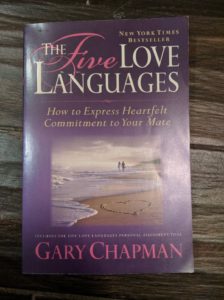 I’ve read many articles that referred to the five love languages – Words of Affirmation, Acts of Service, Receiving Gifts, Quality Time, and Physical Touch – and knowing about them has helped immensely to address misunderstandings in relationships, whether my own or others’. The central premise, in the articles and the book, is that most of us express and prefer to receive love primarily in one or two of these languages and we often blunder by not hitting the right one(s) for our partner. That said, the original book is well worth a read on its own. The author covers each of the love languages in detail and provides a ton of examples from his work as a counselor,. The writing and narrative is very engaging and personal. This book caters specifically to those in existing romantic relationships, but the principles can easily be applied to those that are dating, to introspection of past relationships, and also to expression and expectation of love with friends and children. It’s worth noting that there’s religious undertones to the writing but in my opinion it’s more related to the author’s background in community, and does not come off preachy at all – I found it rather personable.
I’ve read many articles that referred to the five love languages – Words of Affirmation, Acts of Service, Receiving Gifts, Quality Time, and Physical Touch – and knowing about them has helped immensely to address misunderstandings in relationships, whether my own or others’. The central premise, in the articles and the book, is that most of us express and prefer to receive love primarily in one or two of these languages and we often blunder by not hitting the right one(s) for our partner. That said, the original book is well worth a read on its own. The author covers each of the love languages in detail and provides a ton of examples from his work as a counselor,. The writing and narrative is very engaging and personal. This book caters specifically to those in existing romantic relationships, but the principles can easily be applied to those that are dating, to introspection of past relationships, and also to expression and expectation of love with friends and children. It’s worth noting that there’s religious undertones to the writing but in my opinion it’s more related to the author’s background in community, and does not come off preachy at all – I found it rather personable.
What Makes Love Last?: How to Build Trust and Avoid Betrayal, by John M. Gottman (audiobook version)
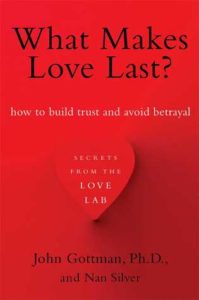 I’ve encountered this author’s research work in many other books I’d read and thought it was about time I took a firsthand look at his writing. The author states that the core of good relationships is trust more than anything else. In addition to his famous work on the concept of “bidding” – where a relationship’s health can be determined by how a whether someone responds to their partner’s bids for attention positively, negatively, or neutrally – the author delves into a number of other areas including blocks to making good relationships great, salvaging damaged relationships, and determining when it’s time to call it quits. Although this book focuses solely on romantic relationships, I believe many of his principles apply to friendships as well. A great book and I highly recommend the print version as there’s a lot of reference material and lists and stuff that’s not really easy to refer back to with the audiobook version.
I’ve encountered this author’s research work in many other books I’d read and thought it was about time I took a firsthand look at his writing. The author states that the core of good relationships is trust more than anything else. In addition to his famous work on the concept of “bidding” – where a relationship’s health can be determined by how a whether someone responds to their partner’s bids for attention positively, negatively, or neutrally – the author delves into a number of other areas including blocks to making good relationships great, salvaging damaged relationships, and determining when it’s time to call it quits. Although this book focuses solely on romantic relationships, I believe many of his principles apply to friendships as well. A great book and I highly recommend the print version as there’s a lot of reference material and lists and stuff that’s not really easy to refer back to with the audiobook version.
Finding Your Perfect Match: 8 Keys to Finding Lasting Love Through True Compatibility, by Pepper Schwartz
 This was recommended to me by a friend and given that I’ve been in the midst of assembling a concrete set of principles that make for a good relationship, romantic and otherwise, it was right up my alley. The author discusses 8 particular personal characteristics and how combinations of them help determine romantic compatibility with another individual, much like in a Myers-Briggs fashion. The author does a great job breaking down these characteristics and demonstrating how they impact a relationship. However, I don’t buy the author’s claim that four of these traits ought to be more similar between two people while the other four need to be more different. Even the author appears to contradict herself as she explains exceptions in all of these cases. That said if you follow the details and ignore this glaring high level error, the information pretty solid.
This was recommended to me by a friend and given that I’ve been in the midst of assembling a concrete set of principles that make for a good relationship, romantic and otherwise, it was right up my alley. The author discusses 8 particular personal characteristics and how combinations of them help determine romantic compatibility with another individual, much like in a Myers-Briggs fashion. The author does a great job breaking down these characteristics and demonstrating how they impact a relationship. However, I don’t buy the author’s claim that four of these traits ought to be more similar between two people while the other four need to be more different. Even the author appears to contradict herself as she explains exceptions in all of these cases. That said if you follow the details and ignore this glaring high level error, the information pretty solid.
Worlds Beyond
Zen and the Art of Motorcycle Maintenance: An Inquiry Into Values, by Robert M. Pirsig
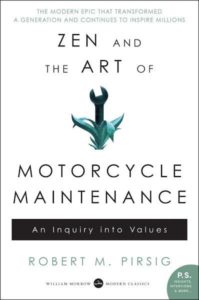 This American classic is essentially two books – one about a father and son motorcycle trip across parts of America, the other about philosophy – and they’re weaved together through the application of philosophical concepts to modern culture and maintaining motorcycles, and also a curious mystery involving the author’s past. The portion about the trip reads like an enjoyable novel despite that it consists of accounts of fact, and the portion regarding the author’s past is gripping. The philosophical portions however seemed rather heavy handed and tough to read when discussing abstract concepts. But perhaps it’s just over my head and something I’ll come to understand when I reread the book in a future life. All that said, the real gem in this book for me was the concrete application of philosophical concepts. The author does an exceptional job defining the concepts and using them to slice our world via insightful lenses and explores areas I’ve given much thought to myself. Like what drives motivation when working on a project. Or what makes something more like art with its romance and beauty versus something more akin to science with its logic and organization.And of course there’s the greater societal implications regarding these philosophies. Overall this was an exceptional read and I highly recommend it.
This American classic is essentially two books – one about a father and son motorcycle trip across parts of America, the other about philosophy – and they’re weaved together through the application of philosophical concepts to modern culture and maintaining motorcycles, and also a curious mystery involving the author’s past. The portion about the trip reads like an enjoyable novel despite that it consists of accounts of fact, and the portion regarding the author’s past is gripping. The philosophical portions however seemed rather heavy handed and tough to read when discussing abstract concepts. But perhaps it’s just over my head and something I’ll come to understand when I reread the book in a future life. All that said, the real gem in this book for me was the concrete application of philosophical concepts. The author does an exceptional job defining the concepts and using them to slice our world via insightful lenses and explores areas I’ve given much thought to myself. Like what drives motivation when working on a project. Or what makes something more like art with its romance and beauty versus something more akin to science with its logic and organization.And of course there’s the greater societal implications regarding these philosophies. Overall this was an exceptional read and I highly recommend it.
Life of Pi, by Yann Martel
 This work of fiction is wonderful. Not only is it engaging, but it really makes you believe something absurd. The bulk of the story involves a boy castaway on a lifeboat with a tiger as his “companion”. In this regard it’s quite reminiscent of “The Martian” (the book and not the dumbed down movie) where the main character must come up with clever solutions to survive seemingly impossible circumstances. An unexpected gem in this book involves philosophy about religion, society, and one’s own behavior, with much of it captured in the first part of the book. There’s also quite a bit of interesting discussion on animal behavior which I really enjoyed. It’s worth noting that this work is written mostly in first person, something that makes a huge difference to me as I find third person fiction – with dialogues of multiple characters – difficult to follow. Go read this book. You’ll love it!
This work of fiction is wonderful. Not only is it engaging, but it really makes you believe something absurd. The bulk of the story involves a boy castaway on a lifeboat with a tiger as his “companion”. In this regard it’s quite reminiscent of “The Martian” (the book and not the dumbed down movie) where the main character must come up with clever solutions to survive seemingly impossible circumstances. An unexpected gem in this book involves philosophy about religion, society, and one’s own behavior, with much of it captured in the first part of the book. There’s also quite a bit of interesting discussion on animal behavior which I really enjoyed. It’s worth noting that this work is written mostly in first person, something that makes a huge difference to me as I find third person fiction – with dialogues of multiple characters – difficult to follow. Go read this book. You’ll love it!
Einstein’s Dreams, by Alan Lightman
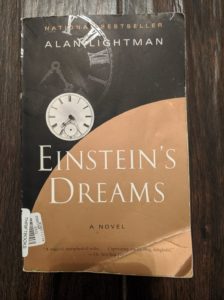 This brief novel is a collection of wonderful short stories, each a few pages long, that explore various worlds where time operates in different ways and the stunning manners in which people operate under such circumstances. In one story, time repeats over and over again. In another, time moves slower for those at altitude but not so for those that aren’t. The stories are predicated on fictional dreams being had by Einstein as he was working out his theory of relativity in 1905. I really enjoyed each story, and often had to pause for minutes or even hours in between them to grasp the universe, happenings, and implications of each one. Well worth a read.
This brief novel is a collection of wonderful short stories, each a few pages long, that explore various worlds where time operates in different ways and the stunning manners in which people operate under such circumstances. In one story, time repeats over and over again. In another, time moves slower for those at altitude but not so for those that aren’t. The stories are predicated on fictional dreams being had by Einstein as he was working out his theory of relativity in 1905. I really enjoyed each story, and often had to pause for minutes or even hours in between them to grasp the universe, happenings, and implications of each one. Well worth a read.